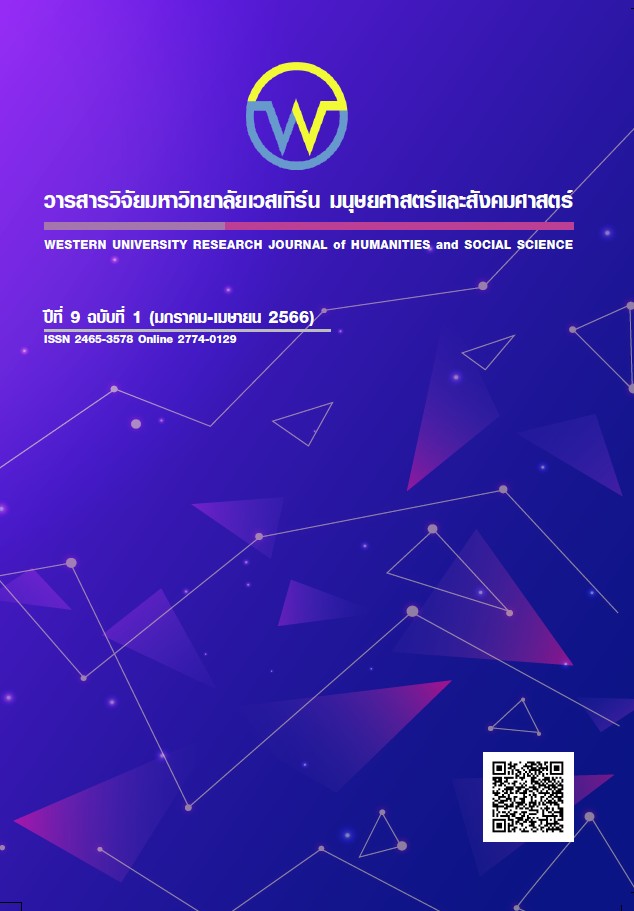การรับรู้เทคโนโลยี และนวัตกรรมผลิตภัณฑ์ในฐานะตัวแปรคั่นกลางที่เชื่อมโยงศักยภาพผู้ประกอบการสมัยใหม่สู่ความยั่งยืนของธุรกิจชุมชนในอำเภอปากเกร็ด จังหวัดนนทบุรี
Main Article Content
บทคัดย่อ
การวิจัยครั้งนี้มีวัตถุประสงค์เพื่อศึกษา 1) ระดับศักยภาพผู้ประกอบการสมัยใหม่ การรับรู้เทคโนโลยี นวัตกรรมผลิตภัณฑ์ และความยั่งยืนของธุรกิจชุมชน และ 2) นวัตกรรมผลิตภัณฑ์ และการรับรู้เทคโนโลยีในฐานะตัวแปรคั่นกลางที่เชื่อมโยงศักยภาพผู้ประกอบการสมัยใหม่สู่ความยั่งยืนของธุรกิจชุมชน เครื่องมือที่ใช้ในการวิจัยครั้งนี้ คือ แบบสอบถาม ทำการเก็บข้อมูลกับผู้ประกอบธุรกิจชุมชนภายในอำเภอปากเกร็ด จังหวัดนนทบุรี จำนวน 500 คน ตามแนวคิดของ Comrey and Lee (1992) ด้วยวิธีการไม่อาศัยความน่าจะเป็น และใช้วิธีการเจาะจง สถิติที่ใช้ในการวิจัยครั้งนี้ คือ ค่าเฉลี่ย ร้อยละ ค่าเฉลี่ย ส่วนเบี่ยงเบนมาตรฐาน ค่าสัมประสิทธิ์การกระจาย และการวิเคราะห์สมการโครงสร้าง SEM โดยใช้โปรแกรม ADANCO 2.3 ผลการวิจัยพบว่า 1) ระดับศักยภาพผู้ประกอบการสมัยใหม่ การรับรู้เทคโนโลยี นวัตกรรมผลิตภัณฑ์ และความยั่งยืนของธุรกิจชุมชน อยู่ในระดับมาก มีค่าเฉลี่ยอยู่ที่ 3.85, 3.84, 3.54 และ 3.83 และส่วนเบี่ยงเบนมาตรฐานอยู่ที่ .695, .745, .793 และ .833 และสัมประสิทธิ์การกระจายอยู่ที่ .18, .19, .22 และ .21 2) การรับรู้เทคโนโลยี และนวัตกรรมผลิตภัณฑ์ในฐานะตัวแปรคั่นกลางที่เชื่อมโยงศักยภาพผู้ประกอบการสมัยใหม่สู่ความยั่งยืนของธุรกิจชุมชน โดยเรียงค่าอิทธิพลรวมประกอบด้วยศักยภาพผู้ประกอบการสมัยใหม่ (TE=0.715) การรับรู้เทคโนโลยี (TE=0.489) และนวัตกรรมผลิตภัณฑ์ มีอิทธิพลรวมต่อความยั่งยืนของธุรกิจชุมชน (TE=0.641) ซึ่งแสดงให้เห็นว่าศักยภาพผู้ประกอบการสมัยใหม่ ส่งผลต่อความยั่งยืนธุรกิจชุมชนมากกว่า การรับรู้เทคโนโลยี และนวัตกรรมผลิตภัณฑ์
Article Details

อนุญาตภายใต้เงื่อนไข Creative Commons Attribution-NonCommercial-NoDerivatives 4.0 International License.
เอกสารอ้างอิง
กรุงเทพธุรกิจ. (2563). CIBA_มธบ. พลิกฟื้นชุมชนคลองศาลากุลเกาะเกร็ด. สืบค้นเมื่อ 11 พฤศจิกายน 2565, จาก https://www.bangkokbiznews.com/social/861628.
กฤษฎา บุญชัย. (2563). วิกฤตโควิดกับจุดเปลี่ยนของชุมชนท้องถิ่น. สืบค้นเมื่อ 1 พฤศจิกายน 2565, จาก https://thaipublica.org/2020/04/ kritsada-boonchai-14/.
จันทิมา พรหมเกษ, จักเรศ เมตตะธำรงค์ และวรรณิดา สารีคำ. (2562). ผลกระทบของศักยภาพผู้ประกอบการสมัยใหม่ และนวัตกรรมการตลาดที่มีผลต่อความได้เปรียบทางการแข่งขันของวิสาหกิจชุมชนกลุ่มแปรรูปผลิตผลทางการเกษตรในเขตภาคตะวันออกเฉียงเหนือตอนบน. วารสารสุรนารี มนุษยศาสตร์และสังคมศาสตร์, 13(2), 79-96.
พัฒน์กมล อ่อนสำลี. (2564). การปรับตัวของวิสาหกิจชุมชนในสภาวะการแพร่ระบาดของโรคติดเชื้อไวรัสโคโรนา 2019. วารสารวิทยาการจัดการปริทัศน์, 23(1), 195-206.
องค์การบริหารส่วนตำบลเกาะเกร็ด. (2565). ผลิตภัณฑ์ชุมชน. สืบค้นเมื่อ 4 พฤศจิกายน 2565, จาก https://www.kohkred-sao.go.th/public/list/data/detail/id/162/menu/1171/page/1.
Ahn, M., Kang, J., & Hustvedt, G. (2016). A model of sustainable household technology acceptance. International Journal of Consumer Studies, 40(1), 83-91.
Aibar-Guzmán, B., García-Sánchez, I. M., Aibar-Guzmán, C., & Hussain, N. (2022). Sustainable product innovation in agri-food industry: Do ownership structure and capital structure matter?. Journal of Innovation & Knowledge, 7(1), 100160-100172.
Comrey, A. L., & Lee, H. B. (1992). Interpretation and Application of Factor Analytic Results. (Eds.). Hillsdale, NJ: Lawrence Eribaum Associates.
Danquah, M., & Amankwah-Amoah, J. (2017). Assessing the relationships between human capital, innovation and technology adoption: Evidence from sub-Saharan Africa. Technological Forecasting and Social Change, 122(23), 24-33.
Kumar, G., Engle, C., & Tucker, C. (2018). Factors driving aquaculture technology adoption. Journal of the world aquaculture society, 49(3), 447-476.
Hair, J. F., Black, W. C., Babin, B. J., Anderson, R. E., & Tatham, R. L. (2014). Pearson New International Edition. In Multivariate Data Analysis (7th Ed). Essex: Pearson Education Limited Harlow.
Hambleton, R. K., & Cook, L. L. (1977). Latent trait models and their use in the analysis of educational test data. Journal of educational measurement, 14(2), 75-96.
Henseler, J. (2017). ADANCO 2.0.1: user manual. Kleve: Composite Modeling GmbH & Co.
Ionescu, G. H., Firoiu, D., Pîrvu, R., Enescu, M., Rădoi, M. I., & Cojocaru, T. M. (2020). The potential for innovation and entrepreneurship in EU countries in the context of sustainable development. Sustainability, 12(18), 7250-7264.
Munoz, R. M., Sanchez de Pablo, J. D., Pena, I., & Salinero, Y. (2016). The effects of technology entrepreneurship on customers and society: A case study of a Spanish pharmaceutical distribution company. Frontiers in psychology, 7(2), 978-992.
Repnikova, V., Bykova, O., Skryabin, O., Morkovkin, D., & Novak, L. (2019). Strategic aspects of innovative development of entrepreneurial entities in modern conditions. International Journal of Engineering and Advanced Technology, 8(4), 32-35.
Shahzad, M., Qu, Y., Rehman, S. U., & Zafar, A. U. (2022). Adoption of green innovation technology to accelerate sustainable development among manufacturing industry. Journal of Innovation & Knowledge, 7(4), 100231-100243.
Shin, J., Kim, C., & Yang, H. (2018). The effect of sustainability as innovation objectives on innovation efficiency. Sustainability, 10(6), 1966-1981.


